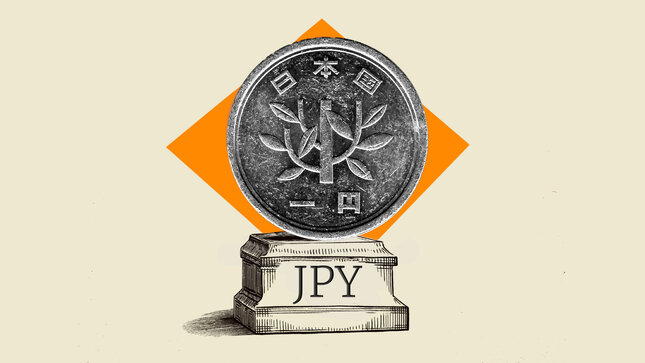The Japanese Yen (JPY) edges lower against a broadly firmer US Dollar (USD) during the Asian session on Monday and remains close to a nine-month low touched last week. A government report showed earlier today that Japan’s economy contracted in the July-September period for the first time in six quarters. This comes amid Japan’s Prime Minister Sanae Takaichi’s fiscal stimulus plans and support for ultra-loose monetary policy, dampening bets for a Bank of Japan (BoJ) rate hike and undermining the JPY. This, along with a modest USD uptick, assists the USD/JPY pair in holding steady above mid-154.00s.
The JPY bears, however, seem reluctant to place aggressive bets amid speculations that Japanese authorities might step into the markets to stem further weakness in the domestic currency. Apart from this, a weaker risk tone contributes to limiting losses for the safe-haven JPY. The USD, on the other hand, might struggle to attract further buyers amid concerns about the weakening economic momentum on the back of the longest-ever US government shutdown. This, in turn, warrants some caution before positioning for an extension of the USD/JPY pair’s recent move up witnessed over the past month or so.
Japanese Yen bulls remain on the sidelines as weak GDP print fuels BoJ rate hike uncertainty
- The Cabinet Office reported this Monday that Japan’s economy contracted by 0.4% in the July-September period, marking the first fall in six quarters. Furthermore, the Gross Domestic Product fell 1.8% year-on-year in the September quarter following a 2.3% rise in the previous quarter.
- The readings were less worse than consensus estimates, though pointed to a limited strength in the Japanese economy. This forced investors to pare their bets that the Bank of Japan will hike interest rates soon amid increasing political resistance and undermines the Japanese Yen.
- Japan’s Prime Minister Sanae Takaichi’s administration is compiling a stimulus package to cushion the blow to households from rising living costs. Takaichi said last week that she would work on setting a new fiscal target extending through several years to allow more flexible spending.
- China and Japan exchanged sharp warnings after Takaichi’s remarks over the use of military force in any Taiwan conflict. In response, China threatened severe consequences, raising the risk of further escalation of tensions and the worsening diplomatic standoff between the two nations.
- This, in turn, is seen weighing on investors’ sentiment and offering some support to the safe-haven JPY. Meanwhile, the recent decline in the JPY prompted some verbal intervention from Japanese authorities. This further holds back the JPY bears from placing fresh bets and limits losses.
- In fact, Japan’s Finance Minister Satsuki Katayama said last week that she will be watching FX moves with a sense of urgency. Moreover, Japan’s Economy Minister Minoru Kiuchi said on Friday that a weak JPY can push up CPI through import costs, warranting caution for the JPY bears.
- Meanwhile, a growing number of Federal Reserve policymakers signaled caution on further easing amid the lack of economic data. This tempers expectations for another interest rate cut by the US central bank in December, which lends some support to the US Dollar and the USD/JPY pair.
- The market attention now shifts to the delayed release of the closely-watched US Nonfarm Payrolls report on Thursday. Apart from this, FOMC meeting minutes and Fed speeches will be scrutinized for cues about the future rate-cut path, which should provide a fresh impetus to the buck.
USD/JPY constructive setup backs the case for additional gains; move beyond 155.00 awaited

From a technical perspective, Friday’s goodish rebound from the 153.60 support, representing the 100-period Simple Moving Average (SMA) on the 4-hour chart, and a close above the 154.45-154.50 hurdle favors the USD/JPY bulls. Moreover, oscillators on the daily chart are holding comfortably in positive territory and are still away from being in the overbought zone. Some follow-through buying and acceptance above the 155.00 psychological mark will reaffirm the constructive outlook and lift spot prices to the 155.60-155.65 intermediate barrier en route to the 156.00 round figure.
On the flip side, weakness below the 154.00 immediate support might continue to attract some buyers and find decent support near the 153.60-153.50 region, below which the USD/JPY pair could slide to the 153.00 round figure. The latter should act as a key pivotal point, which, if broken decisively, might shift the near-term bias in favor of bearish traders and drag spot prices to the next relevant support near the 152.15-152.10 area.
Bank of Japan FAQs
The Bank of Japan (BoJ) is the Japanese central bank, which sets monetary policy in the country. Its mandate is to issue banknotes and carry out currency and monetary control to ensure price stability, which means an inflation target of around 2%.
The Bank of Japan embarked in an ultra-loose monetary policy in 2013 in order to stimulate the economy and fuel inflation amid a low-inflationary environment. The bank’s policy is based on Quantitative and Qualitative Easing (QQE), or printing notes to buy assets such as government or corporate bonds to provide liquidity. In 2016, the bank doubled down on its strategy and further loosened policy by first introducing negative interest rates and then directly controlling the yield of its 10-year government bonds. In March 2024, the BoJ lifted interest rates, effectively retreating from the ultra-loose monetary policy stance.
The Bank’s massive stimulus caused the Yen to depreciate against its main currency peers. This process exacerbated in 2022 and 2023 due to an increasing policy divergence between the Bank of Japan and other main central banks, which opted to increase interest rates sharply to fight decades-high levels of inflation. The BoJ’s policy led to a widening differential with other currencies, dragging down the value of the Yen. This trend partly reversed in 2024, when the BoJ decided to abandon its ultra-loose policy stance.
A weaker Yen and the spike in global energy prices led to an increase in Japanese inflation, which exceeded the BoJ’s 2% target. The prospect of rising salaries in the country – a key element fuelling inflation – also contributed to the move.







